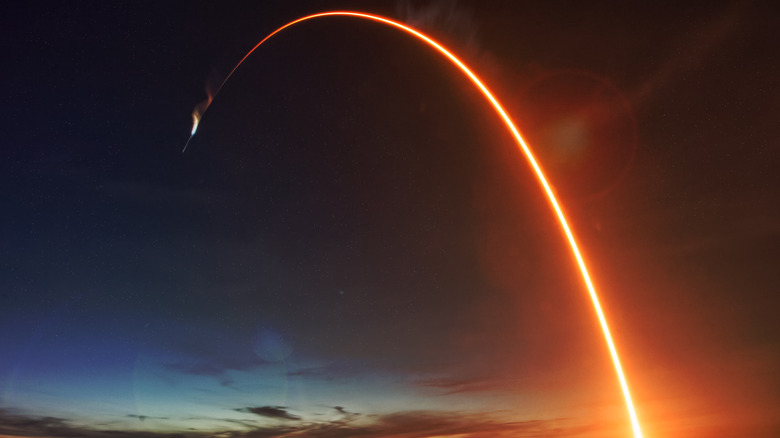America's Cold War Secret: Exploring The 'Rods From God' Space Weapon Concept
Imagine how much damage a lump of metal might do if dropped onto a target from a great height. Now imagine the metal is tungsten — one of the heaviest rare metals — and it's dropped from space, miles above the surface of the earth. Impacting at many times the speed of sound, the kinetic energy released by such a weapon would be immense; more than enough to destroy multiple types of ground targets.
That's the theory behind the so-called "rods from God" concept that the U.S. military developed during the cold war under the codename "Project Thor."
The idea of so-called "kinetic weapons" isn't new. For centuries, people have been dropping heavy things onto people that they don't like. Even as recently as the Vietnam War, the U.S. Air Force deployed "Lazy Dog" projectiles — solid pieces of steel, a couple of inches long, with fins attached. When dropped from thousands of feet up, the weapons could reach a velocity of up to 500 mph, impacting with enough force to penetrate jungle canopy, light-skinned vehicles, and up to nine inches of concrete.
Compared to conventional explosives, the Lazy Dogs were lighter, could be deployed in large numbers, and were far cheaper. Unlike cluster munitions, which have a notoriously high "dud" rate, they posed no risk to civilians after they hit the ground. The minds behind Project Thor, based on ideas originally developed by Boeing scientist Jerry Pournelle back in 1957, took the Lazy Dog concept and made it bigger. Much bigger.
Early research into hypersonic kinetic weapons
The "rods" were to be 20 feet long, and one foot in diameter. When dropped from orbit, the 24,000-pound rods would reach "hypersonic" speeds approaching Mach 10 before impact. While a Lazy Dog might take out a lightly-armored truck or penetrate a building, the scientists behind the "rods from God" envisaged a level of destruction more commonly associated with massive ground-penetrating bombs.
A single "rod" of titanium would have enough kinetic energy to penetrate deep into the earth, destroying any hardened bunkers and underground shelters in its path. Like earlier kinetic weapons, the "rods from God" would be mechanically simple while being virtually impossible to defend against. Unlike nuclear weapons, however, they would create no dangerous fallout.
So why weren't they adopted? Ironically, despite their simplicity, the "rods" would be prohibitively expensive. That's because tungsten is very heavy. NASA estimates that today, it costs around $10,000 to put one pound of weight into orbit, meaning that it would cost around $240,000,000 to get a single "rod" into space. Back in the 1960s, with the rocket technology of the time, it would have been even more expensive.
Like another Cold War weapon, Russia's massive "Tsar Bomba," America's "rods from God" concept never reached fruition during the Cold War, but it wasn't completely shelved. After 9/11, as Western forces hunted Al Qaeda through the mountains of Afghanistan, the concept of hypersonic "bunker-busting" hypersonic weapons was dusted off once again.
A weapon concept that will not die
The proposed Hypervelocity Rod Bundles (HRB) concept would have consisted of a bundle of 6-meter-long tungsten rods launched — you guessed it — from a network of satellites in space, and steered onto their targets below. The U.S. military estimated that such a weapons system could be deployed within a few minutes, far faster than a conventional intercontinental ballistic missile.
As far as we know, the HRB concept was never implemented in an official capacity, partly because of the prohibitive cost of getting that much tungsten into orbit. However, Chinese scientists are once again investigating kinetic hypersonic weapons, and their preliminary findings make for interesting reading.
Researchers at the North University of China in Taiyuan, Shanxi province, working with the university's Intelligent Weapon Research Institute, have successfully accelerated tungsten rods to velocities of up to 6,700mph — almost nine times the speed of sound. Their findings suggest that, on impact with a hardened concrete bunker, the amount of kinetic energy released would create a high-pressure shock wave capable of turning the target from a solid mass to a plasma state — literally liquifying the target.
Practical tests and potential development
However, a practical demonstration in 2018 showed potential, but also raised questions about the usefulness of "rods from God" as a weapon. Scientists released a 308-pound tungsten rod from a classified launch platform high above the Gobi desert, accelerating it to an incredible 10,300 mph (roughly 13 times the speed of sound).
While the "rod" made a large hole in the desert, data collected from the test suggested that a hypersonic kinetic weapon may not be capable of much more ground penetration than conventional "bunker-busting" munitions. Counterintuitively, data indicated that maximum penetration would be achieved at a mere 3.5 times the speed of sound. In other words, accelerating the rods to hypersonic (Mach 5+) speeds wouldn't make any significant difference to their effectiveness.
This may not be the end for the "rods from God" concept, but the jury is still out. It's possible that compared to conventional munitions, chucking huge lumps of metal down from orbit might remain prohibitively expensive. However, tungsten-based kinetic warheads could potentially be launched from new-generation hypersonic missiles or from rail guns (another much-investigated weapon concept that refuses to die), which use electromagnetic fields to fire projectiles at extremely high speeds over great distances.



